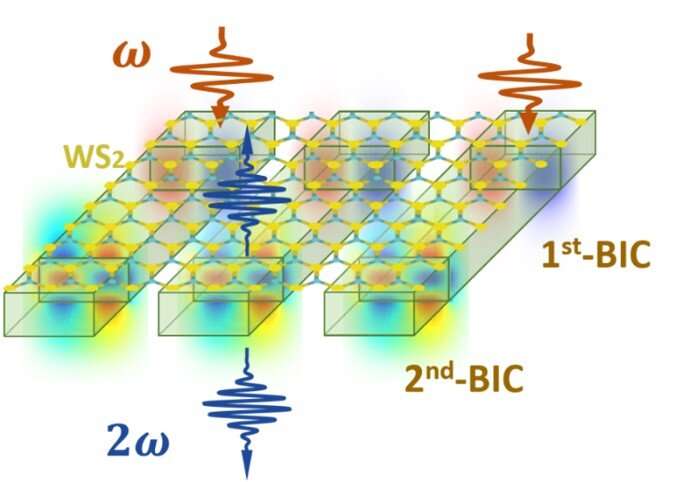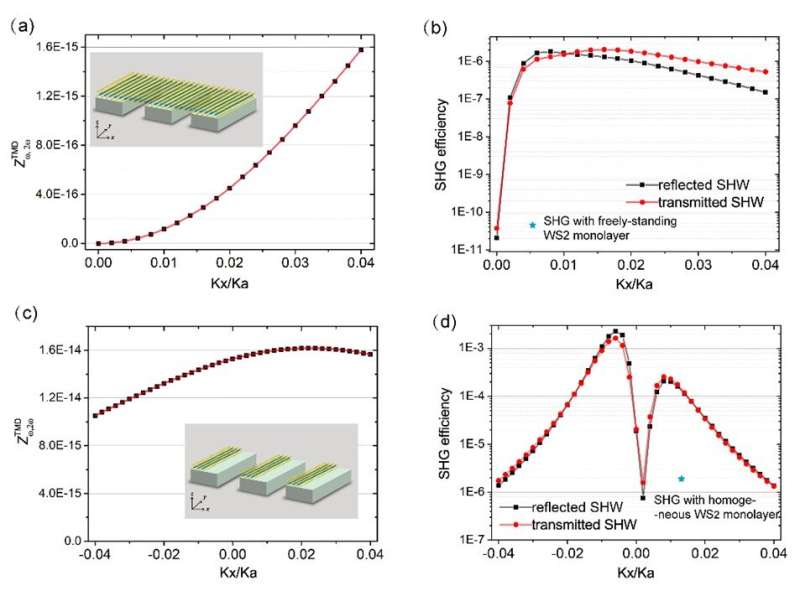Boosting second harmonic generation with TMDs monolayer

Two photons can be merged to generate one photon with doubled frequency in nonlinear optical materials. This process is known as second harmonic generation (SHG), which was first discovered in 1960s, immediately after the invention of the laser. Since then, the development of SHG has led to many applications in advanced technologies, such as on-chip light sources, imaging, sensing, and communications. For example, SHG-based imaging devices, which capture the near-infrared (NIR) light and emit light in the visible range, are at the heart of developing novel all-optical NIR imaging technologies, such as night vision.
While many applications in nonlinear optics have been demonstrated via traditional bulk materials, the recently emerging 2D materials offer unprecedented opportunities in the nonlinear optics field. For example, when the crystals of transition metal dichalcogenides (TMDs) are thinned down to be monolayer, they exhibit direct bandgap, strong luminescence, room-temperature stable excitons and strong second-order nonlinearity. These unique optical properties make monolayers of TMDs an attractive platform for exploring novel linear and nonlinear optical effects and their related applications. However, due to the atomic-scale interaction length with light, a sole TMDs monolayer emits an extremely low SHG signal, significantly hindering the development of practical nonlinear metadevices based on 2D materials.
In recent years, high-refractive-index dielectric nanoresonators have become a promising platform for enhancing SHG. Furthermore, it has been shown that the low SHG efficiency from 2D materials can be addressed by magnifying the strength of the light field within such dielectric resonators. They exhibit negligible optical losses at visible and NIR wavelengths as compared to their plasmonic counterparts. Among various features of dielectric nanoresonators, their capability to exhibit strong confinement of light field, so-called bound state in the continuum (BIC), has been introduced as a unique feature in dielectric nanoresonators. BIC's eigenfrequency, lying in the continuum spectrum, has emerged as a promising approach to enhance SHG in 2D materials.

Recently, an international team involving the University of Electronic Science and Technology of China and Nottingham Trent University has proposed a dual BICs scheme with the fundamental and the second harmonic waves in resonance simultaneously to boost the conversion efficiency of SHG from TMDs monolayer. As shown in Fig. 1, the pair of BICs are cavity modes within a carefully designed GaP grating slab. By transferring the TMDs monolayer onto the BICs slab, the SHG signal of TMDs monolayer can be largely amplified due to the dual-BICs resonance process. In other words, the electric field of the fundamental light can be significantly enhanced by exciting the first BIC, and meanwhile, the excitation of the second BIC at harmonic wavelength will further boost the nonlinear emission.
The main challenge in this study was the spatial mode matching within the TMD monolayer between the BIC-resonant fundamental and second harmonic wave. The researchers have shown that slightly tilting the incident angle of the fundamental wave can greatly improve the spatial mode matching within the TMDs monolayer, giving rise to four orders of magnitude enhancement of the SHG efficiency, as compared to that with a sole TMDs monolayer [see Figs. 2(a)–(b)]. Moreover, by exploring the 2D nature of the TMDs monolayer, the researchers have demonstrated that patterning the TMDs monolayer can optimize spatial mode matching. This will further boost the SHG process of TMDs monolayer and amplify SHG signal up to seven orders of magnitude, as shown in Figs. 2(c)–(d).
These results, published in Opto-Electronic Advances, offer new possibilities to enhance SHG in practical applications with TMDs monolayers, demonstrating new opportunities for nonlinear optics with atomic thin 2D materials, including new type of light sources, all-optical night vision technology based on frequency conversion.
More information: Peilong Hong et al, Dual bound states in the continuum enhanced second harmonic generation with Transition Metal Dichalcogenides monolayer, Opto-Electronic Advances (2022). DOI: 10.29026/oea.2022.200097
Provided by Compuscript Ltd





















